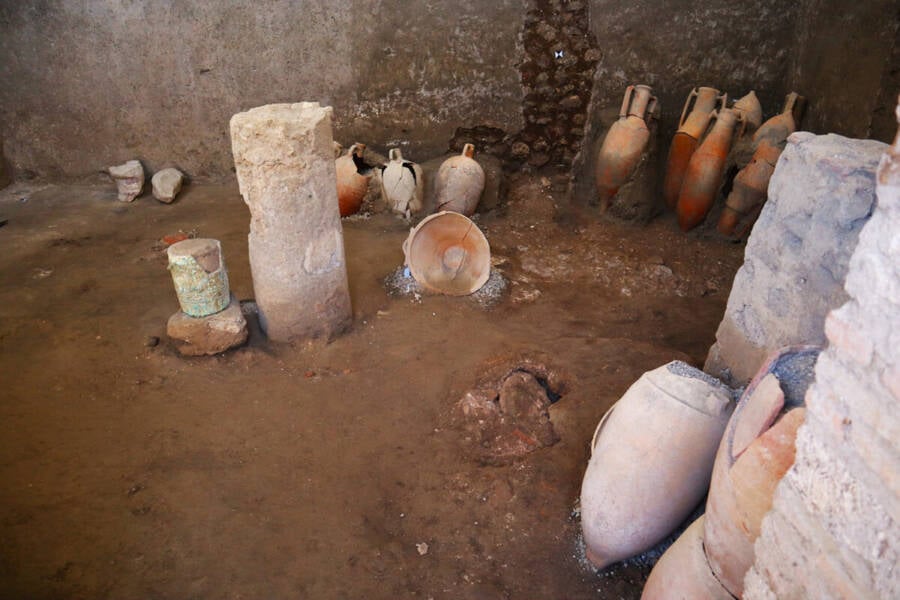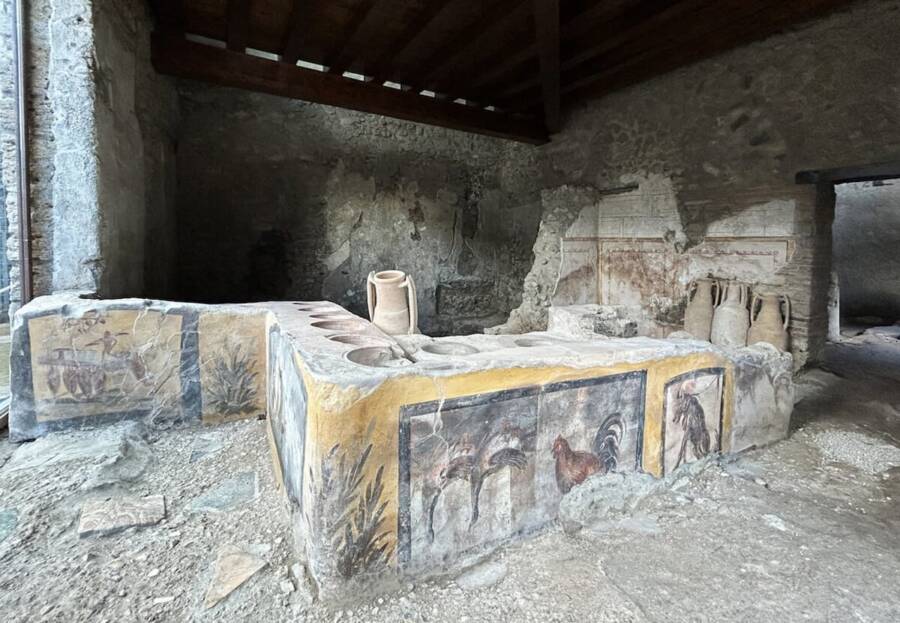The glazed ceramic vessel, which was decorated with hunting scenes, was seemingly used as a food storage container in a popina, or food stand.

Parco Archeologico di PompeiThe vase is made of a glazed ceramic known as faience.
During excavations of a Pompeii food stand known as the Thermopolium del Gallo (Thermopolium of the Rooster), archaeologists came across a curious object: an ornate vase with Egyptian origins. Normally found in gardens or wealthy estates, the vase was seemingly used as a storage container by the owners of a “fast food” shop.
What’s more, the way the shop slowly collapsed around the vase during the eruption of Mount Vesuvius in 79 C.E. made it so that the Thermopolium del Gallo seems frozen on the deadliest day in Pompeii’s existence.
The Egyptian Vase Unearthed From The Rubble Of A Pompeii Fast Food Store
According to a statement from the Parco Archeologico di Pompei, the ornate Egyptian vase was found during excavations in Insula 3 of Region V of Pompeii between late 2023 and May 2024.

Parco Archeologico di PompeiThe Egyptian vase was excavated from the rubble between 2023 and 2024.
Found amid pots, mortars, and amphorae amid the destruction of the Thermopolium del Gallo (a “thermopolium” was a place where hot food was sold), the vase has clear Egyptian origins. It’s made of faience, a glassy green-yellow ceramic popular in Egypt, and is decorated with hunting scenes that include humans, animals, and vegetation. Archaeologists suspect that it was made in Alexandria before it made its way to Pompeii.
But while the existence of Egyptian items in the Roman empire is not unusual, the vase’s location in Pompeii is surprising. Normally, objects like this would be a “prized decorative element in gardens and stately spaces.” But in this case, the vase was seemingly used as kitchen storage.
“We see here a certain creativity at work in furnishing sacred and profane spaces, namely the domestic altar and the kitchen, with objects that testify to the permeability and mobility of tastes, styles and likely also religious ideas in the Roman Empire” Gabriel Zuchtriegel, the director of the Pompeii Archaeological Park, explained in the press release.

Parco Archeologico di PompeiKitchen objects, including amphorae, mortars, and a bronze cauldron, which were also found during excavations of the Thermopolium del Gallo alongside the Egyptian vase.
Zuchtriegel continued: “[W]e see this phenomenon here not at an elite level, but in the back room of a popina, a street food stand in Pompeii, that is, at a lower-middle level of local society, which however proved essential in the promotion of Eastern cultural and religious forms, including Egyptian cults, but later also Christianity.”
Not only is the placement of the vase in the back of a food stand surprising, but the ruins of the Thermopolium del Gallo also offer new insights into the destruction of Pompeii.
The Destruction Of The Thermopolium Del Gallo When Mount Vesuvius Erupted
During the larger excavation of the Thermopolium del Gallo, archaeologists determined that the business was made up of two levels. On the first, there were a bathroom, what appeared to be a kitchen, and a variety of utensils. On the second, archaeologists found a residence that may have belonged to the food stand’s owners. Not only did the home show signs of luxurious decoration, but archaeologists also found a small wooden chest that contained hairpins made of bone and glass perfume bottles.

Parco Archeologico di PompeiThe Thermopolium del Gallo food stand where the Egyptian vase was discovered.
Archaeologists determined that the food stand was in somewhat poor shape. Possibly damaged by earthquakes that preceded the eruption of Mount Vesuvius, the food stand showed signs of “structural modifications” and “emergency repairs,” though it was seemingly still in use.
Then, in 79 C.E., disaster struck when the nearby volcano erupted.
Based on the ruins of the Thermopolium del Gallo, archaeologists were able to determine how gray and white pumice, then ash, slowly filled the restaurant space. At some point, the strain caused a shelf above the amphorae to collapse, sending its objects spilling toward the building entrance. And ultimately the top floor collapsed down onto the bottom floor, which pinned the layout of the food stand in place for the next 2,000 years.
As such, the discovery of the vase presents as many questions as it does answers. While the ruins of the Thermopolium del Gallo offer an intimate look at how the eruption of Mount Vesuvius impacted Pompeii, the placement of the vase in the back of the restaurant remains a curiosity. How did such a precious object make its way into the kitchen of a food stand? For now, the answer remains hidden under the rubble of the doomed city.
After reading about the Egyptian vase found in Pompeii, discover the stories of 11 of the most famous gladiators in ancient Rome. Or, go inside the complicated question of why the powerful Roman Empire eventually collapsed.





